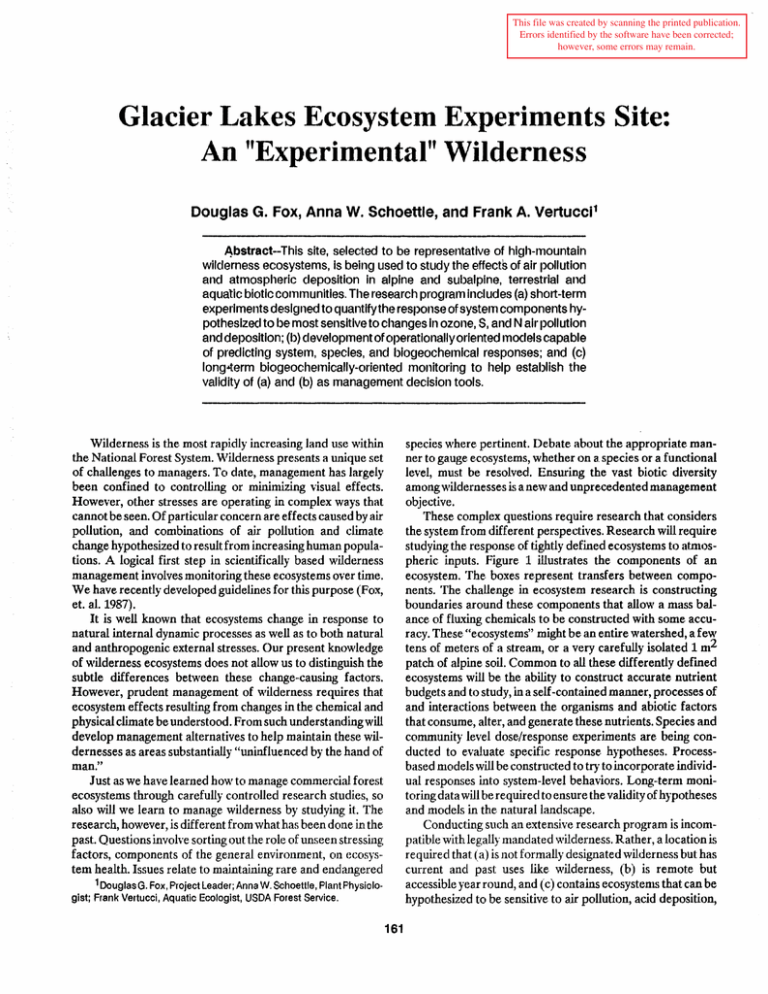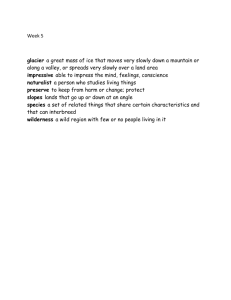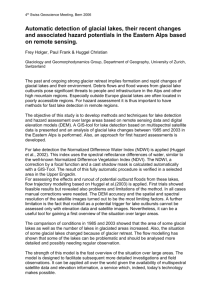Glacier Lakes EcosystelD Experinlents Site: An "Experinlental" Wilderness
advertisement

This file was created by scanning the printed publication.
Errors identified by the software have been corrected;
however, some errors may remain.
Glacier Lakes EcosystelD Experinlents Site:
An "Experinlental" Wilderness
Douglas G. Fox, Anna W. Schoettle, and Frank A. Vertucci 1
Abstract--This site, selected to be representative of high-mountain
wilderness ecosystems, is being used to study the effects of air pollution
and atmospheric deposition In alpine and subalpine, terrestrial and
aquatic biotic communities. The research program Includes (a) short-term
experiments designed to quantify the response of system components hypothesized to be most sensitive to changes In ozone, 8, and N air pollution
and deposition; (b) development of operationally oriented models capable
of predicting system, species, and biogeochemical responses; and (c)
10ng4:erm biogeochemically-oriented monitoring to help establish the
validity of (a) and (b) as management decision tools.
Wilde.rness is the most rapidly increasing land use within
the National Forest System. \\'ilderness presents a unique set
of challenges to managers. To date, management has largely
been confined to controlling or minimi.zing visual effects.
However, other stresses are operating in complex ways that
cannot be seen. Of partie-ular concern are effects caused by air
pollution, and combinations of air pollution and climate
change hypothesized to result from increa.sing human popula.tions. A logical first step in scientifically based wilderness
management involves monitoring these ecosystems over tinle.
We have recently developed guidelines for this purpose (Fox,
et. a1. 1987).
It is well known that ecosystems change in response to
natural internal dynamic processes as well as to both natural
and anthropogenic external stresses. Our present knowledge
of wilderness ecosystems does not allow us to distinguish the
subtle differences between these change-causing factors.
However, prudent management of wilderness re.quires that
ecosystem effects resulting from changes in the chemical and
physical climate be understood. From such understanding will
develop management alternatives to help maintain these wilde.rnesse.s as areas substantially "uninflue.nced by the hand of
nlan."
Just as we have learned how to manage commercial forest
ec.osystems through carefully c.ontrolled research studies, so
also will we learn to manage wilderness by studying it. The
research, however, is different from what has been done in the
past. Questions involve sorting out the role of unseen stressing
factors, components of the general environment, on ecosystem health. Issues relate to maintaining rare and endangered
species where pertinent. Debate about the appropriate manner to gauge ecosystems, whether on a. spedes or a functional
level, must be resolved. Ensuring the vast biotic diversity
among wildernesses is a new and unprecede.nted management
objective.
These complex questions require research that considers
the system from different perspective.s. Research will require
studying the response of tightly defjned e.c.()systems to atmospheric. inputs. Figure 1 illustrates the components of an
e.cosystem. The boxes re.present transfe.rs between components. The challenge in ecosystem research is constructlng
boundarie.s around these components that allow a mass balance of flu."{ing chemicals to be constructed with some ac·curacy. The.se "ecosystems" might be an entire watershed, a few
tens of meters of a stream, or a very carefully isolated 1 m2
patch of alpine soil. Common to all these differently defined
ecosystems will be the ability to construct accurate nutrient
budgets and to study, in a se.lf -contained manner, processes of
and interactions between the organisms and abiotic factors
that consume, alter, and gene.rate these nutrients. Spedes and
community leve.l dose/response expedments are being conducted to evaluate specific response hypotheses. Processbased models will be constructed to try to incorporate individual responses into system-level behaviors. Long-term monitoring data will be required to ensure the validity of hypotheses
and models in the natural landscape.
Conducting such an extensive researc.h program is incompatible with lega1.ly mandated wilderness. Rather, a location is
required that (a) is not formally designated wilderness but has
current and past uses like wilderness, (b) is remote but
accessible year round, and (c) contains ecosystems that can be
hypothesized to be sensitive to air pollution, acid deposition,
1Douglas G. Fox, Project Leader; Anna W. Schoettle, Plant Physiologist; Frank Vertucci, Aquatic Ecologist, USDA Forest Service.
161
and dimate change. To find the best possible location for this
research program, we spent 2 years evaluating potential
locations. This involved a large number of scientists and a field
season of data collection before the final site was selected.
Selection was based on a set of criteria that induded
logistical factors (ownership, permission to conduct research,
accessibility, historic data) and ecological factors (excellent
air quality, alpine/subalpine type, nonweatherable bedrock,
lakes, water with ANC < 50 ueq/l, soils with base saturation
less than 25%). Ecological criteria were based on the hypothesis that curre.ntly unimpacted systems exhibiting low buffering
capacity are likely to be maximally sensitive to air pollution
inputs. The buffering capacity was gauged by acid ne.utralizing
capacity (ANe) of the surface waters, relati.ve mineral weathering potential of bedrock, and exchange capacity of the soils.
An alpine location was desired that collects large a.mounts of
snow. The snowpack effectively accumulates and stores pollution on the site until spring me~t. Spring brings a pulse of
chemicals delivered rapidly to th~ ecosystem. This can result
in a temporary change in lake chemistry which, depending on
lake pH, may cause changes in the biotic complex. Such a
location is dearly the most sensitive from an aquatic perspective. In dean air, ozone concentrations tend to increase with
eleva.tion. Climate influences are dominant factors in the
alpine, tree line providing a dramatic example. It is therefore
reasonable to hypothesize that alpine locations will be most
sensitive from a terrestrial perspective as well.
I Aerosol
I
GLACIER LAKES ECOSYSTEM EXPERIMENTS SITE
Location and Topography
GLEES is located on the Medicine Bow National Forest
approximately 65 km W of Laramie, Wyoming. The site is a
high (3,400 m) glac.ial cirque basin, containing three small lake
watersheds (104, 52, and 43 ha) fed by first-order pere.nnial
streams generated from permanent snow fie.1ds (fig. 2). Ve.getative cover is primarily subalpine, with a sparse Engelmann
spruce-subalpine fir forest (including krummholz stands),
forb-dominated snowpatch communities, and sedge meadows. Soils are minimally developed. Geologically, the basin is
uniform quartzite (75-80%) crossed by i.ntrusions of amphibolite, a mineralogically complex and active mafic rock. Water
chemistry is dominated by snow chemistry except for streams
that run through sufficient mafic materials to reflect weathering processes. Lake water is extremely low in ionic strength;
alkalinities are on the order of 40 ueq/l.
Meteorology and Air Quality
ATMOSPHERE
~
All these criteria are met at the Glacier Lakes Ecosystem
Experiments Site (GLEES).The site and the research program currently underway there are described in the remaining
sections of this paper.
I
Cloud
Water
"
c
0
Data have been collected in the vicinity of the Glacier
Lakes since the late 1960' s, primarily for measuring the
contribution of the Snm,,}, Range to Wyoming water resources
(\\'esche 1982). Mean temperatures measured near the watershed range from lows of -100 F to highs of 300 F in winter and
lows of 2(Y' F to hi.ghs of 70<> F in summer. Wind speed, on the
exposed locations of the watershed, can avera.ge above 15 mph
for months at a time. Precipitation is highly variable across the
watershed but averages 35 inches at Lost Lake, 42 inches
between East and West Glacier Lakes, and 49 incheos near the
East Glacier Lake outlet.
Although no air quality measurements have yet been
recorded, the area is assumed to be clean base.d on the
chemistry of precipitation. A wet/dry precipitation c.olIeetor
operated by the Wyoming \\' ater Research Ce.nter for the
National Add Deposition Program on the southwest side of
\\'est Glacier Lake since April, 1986, indicate.s sulfate and
nitrate concentrations generall.y below western averages.
Air quality measurements will be initiated on the watershed in 1987.
,~
+=<
°
00
0
a.
Q)
0
c
Q)
+=<
°
00
c
,Ir
~. It
I
Organic
I
I
Mineral
I
0
.E
-0
:::J
>-
en
C
co
~
0
0
(3
,
r
0
0a.
co
>
UJ
,.....--
,If
TERRESTRIAL ORGANICS
,
I
~
a.
Q)
Melt
I
c
~
05.
0
.Ir
SOIL/ROCK
Litter
c
co
a.
0
SNOW PACK
Ice Surface
0
:g
0
I
14-
Trees
I
II
Other
Vegetation
,•
I I
I
Litter
Soil
Water
Ground
Water
I
I
I Surface Runoff
,t
.It
WATER & AQUATIC ORGANICS
~
Iplanktonl IBenthosl
I
Sediments
G('ol()l~y
and Soils
The geology of GLEES has recently been described by
Rochette (1987) and the soils by Hopper and \\'althall (1987).
Local alpine glac.iation caused three cirques or nivation basins
I
Figure 1.--Box and line diagram of GLEES.
162
Figure 2.--The GLEES contour and geologic map. Dashed lines Illustrate mafic dykes Into the
surrounding quartzite. The geological mapping Is only In the boxed areas.
to form on the south side of the primary ridge line. Bedrock is
quite uniform, consisting of l\fedidne Peak quartzite intruded
with 15-20% mafic dykes of amphibolite. The significance of
the mafic rock is that it is considerably richer in minerals. The
chemistry of surface waters in the streams feeding West
Glacier Lakes appears to be dominated by weathering of the
mafic rocks. Neverthele.ss, thi.s weathering rate is not likely to
increase with acid de.position, and because of minimal soilwater contact, the wate·rsheds are considered quite sensitive to
increases in acid deposition (e.g., the watershed buffering
capacity is small) (Rochette 1987).
Lakes and Streams
Lost Lake is the largest (6 ha) and highest (3332 m) of the
three lakes. East Glader Lake is 2.8 ha with a watershed of
approximately 43 ha. Vlest Glacier Lake is 2.6 ha with a
watershed of approximately 52 ha. Four streams, as shown i.n
figure 2, feed West Glacier La.ke. Inflow to East Glacier Lake
is largely accomplished by nonchannelized flow and therefore,
appears to be rela.tively more subject to interactions with
watershed soils and vegetation.
Lakes and the West Glacie.r outlet stream support brook
trout populations. In addition, East Glacier supports a cutthroat trout population. Macroinvertibrate sampling suggests
a relatively depopulate community of cold water species in the
stream. Lake and stream add neutralizing capacities are low
ranging between 30 and 50 ueq/l.
Vegetation
The watersheds are predominantly subalpine with considerable abundance of alpine ta~a (Simmons 1987). The forested
areas (35% of the area) are Engelmann spruce- subalpine fir,
which also form krummholz stands at more exposed locations
(fig. 3). An occasional limber pine can be identified. A total of
135 plant taxa have been identified on the watersheds. Many
are alpine species, particularly in the meadow and cushionpla.nt assemblies. Herbac.eous vegetation types (meadows,
cushion-plant-dominated ridge tops, and partially vegetated
scree) make up 30%, while willow-shrub types (willow and wet
me·adow willow) c.omprise the remaining 5%, which is significantly vegetated.
THE RESEARCH PROGRAl\1
The si.te wi1l be used for long-term ecosystem study. The
study will be watershed oriented, namely individual watersheds and subcatchments withi.n these watersheds will be
identified, gauged, and studied. Figure 1 can be used to
represe.nt a si.mple conceptual model of the GLEES. Our
research plans include measurement of the reservoirs and as
many of the transfers as are practical. Within this framework,
163
seA LE I' 6000
KEY
D
0
D
TO
VEGETATION / LANDSCAPE TYPES
Cushion Plants/Stone Pavement'
Scree / Meadow
D
Coniferous Forest> 60
Meadow
Krummholz Conifer>60 % cover
[!]
Coniferous Forest 20-60 % cover
Krummholz Conifer 20-60 % cover
8
. c::J
0
Willow Shrub / Wet Meadow
~
0(0 cover
Scree
G
Rock Outcrop
8
Water
0
Snow
Figure 3.--Vegetatlon and landscape types on the GLEES.
detailed budgets associated with the reservoirs themselves will
be constructed. "'here possible, paired systems wiH be identified or constructed so that manipulation experiments can be
conducted with controls.
Wet DelJOsition.--The objective of wet deposition measurement is to further characterize chemical inputs to the
GLEES. It also is a major transfer from the atmospheric
compartment. A wet deposition collector has been operating
at the site since Spring, 1986. Additional bulk precipitation
samplers will be installed at various locations on the GLEES
in order to establish input chemical variances.
Dry Deposltion.--The objective of dry deposition research
is to try to directly measure this most illusive component of
atmospheric transfer. To date no dry deposition measurement
has been made in a complex-terrain forested setting.
Atmospheric Compartment
The careful measurement of atmospheric i.nput to the
GLEES will be a hallmark of this research. In additi.on to
measurements, the Topographic Air Pollution Analysis System (TA.PAS), a comprehensive set of meteorologically based
state-of-sc.ience computer simulation models will be used to
help characterize the atmospheric compartment. Specific
studies indude:
l\-leteorology.--The objective of meteorological studies is
to characte.rize the overall meteorology and climate of the
GLEES. The relatively uniform terrain of the GLEES allows
a minimum of measurements to accomplish this (fig. 4).
Instrumentation has been installed at two locations on the
GLEES. At each a tower has been erected well above the
forest vegetation. Both are instrumented with wind speed,
direction, temperature, and humidity. Planned expansion
includes multiple levels of turbulence and radiation instrumentation.
Air Quality.-··The objective of air quality measurement is
to help characterize chemical inputs to the GLEES. It is a
measure of the amount of chemicals in the atmospheric
compartment and helps in the measurement: of dry deposition,
one of the major unknown transfers from the atmospheric
com partment.
Snow Pack Compartment
Snow pack is considered a separate component of the
ecosystem because of its importance to the collection and
delive.ry of air pollution and deposition to alpine systems. One
cubic meter of snow contains approximate.ly 104 squa.re meters of surfa.c.e a.rea, about 2 football fields. This vast surfac.e
area is availa.ble to collect and hold pollution. Considerable
researc.h on snow chemistry and physics processes is underway
within the Atmospheric Deposition Effects research unit. An
a.mbitious field research program centers around a.n attempt
to characterize the rapidly changing chemistry of melting
snow.
T'~J:"restrial
Organic Compartment
Our intere.sts in the terrestrial compartment are both with
the transfer of atmospheric che.micals and nutrients into this
compartment and with dose/response studies of selected
164
Flgu,'e 4...-A three-dlmenslons.ll)erSpectlve of the GLEES vicinity. The maps In later figures cover the
boxed area. Centl:mnlalls located In the lower corner of the map. The map was produced by the
Topographic Air Pollution Analysis System (TAPAS) (Fox, et.al. 1986).
species within this compartment. The objective of thi.s research is to establish the. relative sensitivity of the alpine
floristic component of the GLEES to air pollution and deposition. The first step in this research is to attempt to use a
combination of physiological and morphological information
to screen plants for their theoretical sensitivity. This is a field
activity that will be conducted at the GLEES. The second step
requires manipulation of the "theoretically" sensitive plants
by subjecting them to elevated pollution and deposition.
Lake Studies
We also will attempt to characterize the role played by the
lake in nutrient dynamics of the system. In addition to the
morphometric survey already completed, sediment mappi.ng
and coring will be conducted induding introduction of a
paleolimnological tracer for the future. Seepage meters will be
installed on transects in the lake bottom. The Parshall flumes
in GLEES will be used to aid careful measurement of the
hydrological balance of the watershed.
Fish surveys will be conducted as neede.d to determine the
biomass and condition of this resource. Plankton productivity
will be studied with small containers suspended in the lake
dosed to the system but containing carbon 14. Benthos will be
surveyed by scuba divers.
Soil, Rock and Ground Water Compartment
A soil map of the GLEES has already been prepared. The
ability of the soil to consume H -\- will be studied using the soil
map along with laboratory studies of the soil chemistry such as
S04 and N03 sorption, cation leaching, etc.
SUl\lMARY
Water and Aquatlc Organics Compartment
A broadly based ecosystem research program has been
initiated on the Glader Lakes, T\fedidne Bow NF, Wyomi.ng.
The ecosystem on the Glacier Lakes i.s alpine/subalpine and in
a natural state. Minimal management activity is conducted on
this area which is prototypical of much of the Wilderness
system in the western US. The Glacier Lakes site can be
considered an experimental 'Nilderness. It is expected to
exhibit extreme sensitivity to changes in atmospheric inputs of
chemical nutrients and energy. The research program planned
for the Glacier Lakes will provide new information for managers in the 21st Century. This information is likely to be
Stream Study
The chemistry and biology of a pair of streams, Cascade
and Meadow, will be characteriz.e.(i. One stream will be
manipulated by the input of sulfurk and nitric add. Effects on
the stream biota will. be measured. This study will utiliz.e the
recently constructed gauging stations for each stream, input
reservoirs at the stream head, drift nets and emergence traps
(houses over stream).
165
centered around increase·d world population and manifested
i.n the form of incre.ased re.creational use of areas like the.
Glacier Lakes, and changed climate as a result of increased air
pollution.
Hopper, R. Vol. E.; "Valthall, P. 1\1. 1987. FS contract 28-KS359. Soil surveys for the Glacier Lakes and Lost Lake
watersheds, \\Tyomi.ng and Green Lakes watershe.d and
Niwot Ridge, Colorado. 106 p. Available from: Natural
Resource Ecology Laboratory, Agronomy Department,
Colorado State University, Fort Collins, CO.
Rochette, ElizabethA.1987. Che.mical weathe.ringin the "Vest
Glacier Lake drainage basin, Wyoming: implications for
future acid deposition. Laramie, WY: University of
Wyoming. 138 p.1\f.S. thesis.
Simmons, Carol L. 1987. Characterization of the Glacier
Lakes and Lost Lake watersheds, \\Tyoming: ge.ology,
ve.getation, soils', surface chemistry. Final report; FS
contract 28-KS-359. 128 p. Available from: Natural Resource Ecology Laboratory, Colorado State University,
Fort Collins, CO.
\\Tesche, Thomas A. 1982. The Snowy Range observatory: an
update and review. Completion re.port; Office of Water
Resea.rch and Technology Report A-029-WYO. 310 p.
Available from: Water Resource·s Research Institute,
University of Wyoming, Laramie, \\TY.
REFERENCft:S
Fox, Douglas G.; Bernabo, Christopher J.; Hood, Betsy. 1987.
Guidelines for measuring the physical, chemical, and
biological condition of wilde.rness ecosystems. Gen. Tech.
Rep. RM-146. Fort Colli.ns,CO: U.S. Department of
Agriculture, Forest Sen-ice, Rocky 1\fountain Forest and
Range Experiment Station. ~18 p.
Fox, D. G.; Dietrich, D. L.; 1\{ussard, D. E. [and others). 1987.
In: Zannetti, P., ed. Envirosoft 86: proceedings of the
international conference on development and application
of computer techniques to environme.ntal studies; 1986
November; Los Angeles: CotIlputational Mechanics: 123144.
166








